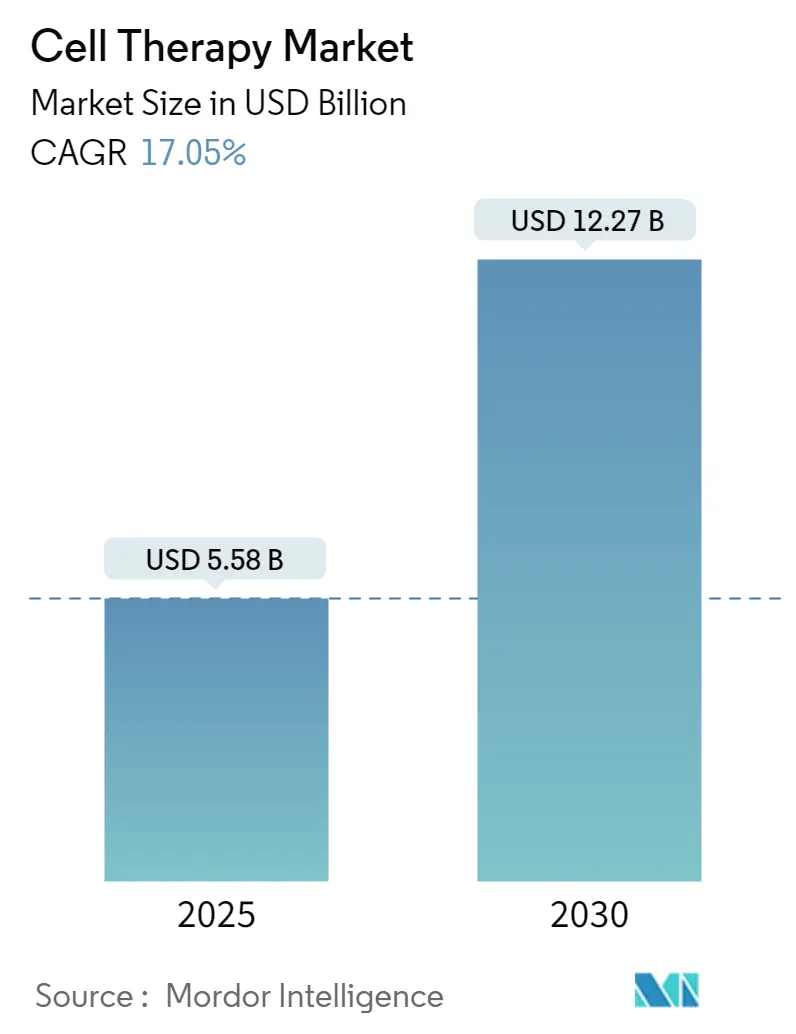
| Study Period | 2021 - 2030 |
| Base Year For Estimation | 2024 |
| Market Size (2025) | USD 5.58 Billion |
| Market Size (2030) | USD 12.27 Billion |
| CAGR (2025 - 2030) | 17.05 % |
| Fastest Growing Market | Asia Pacific |
| Largest Market | North America |
Major Players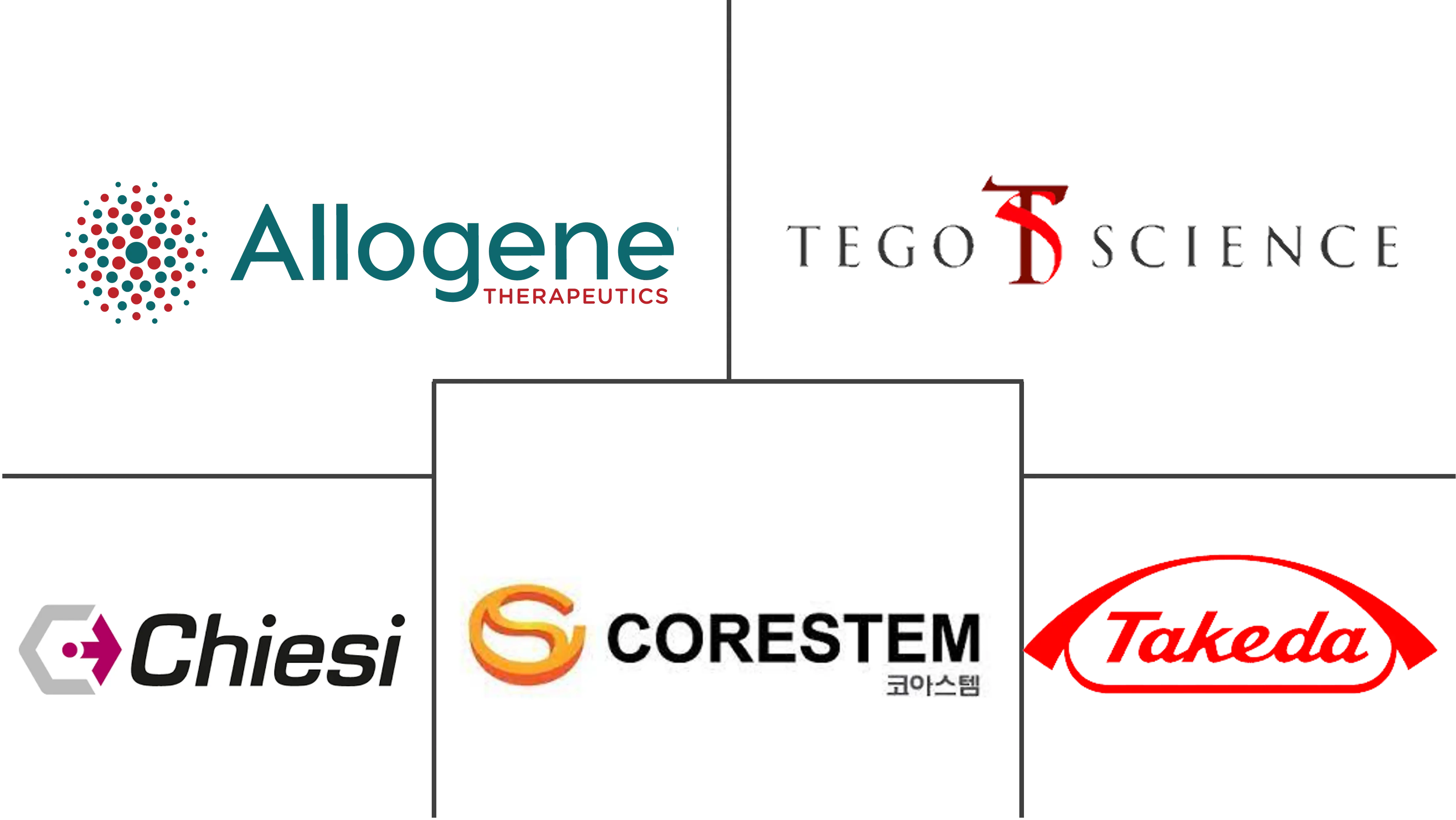
*Disclaimer: Major Players sorted in no particular order |
Cell Therapy Market Analysis
The Cell Therapy Market size is estimated at USD 5.58 billion in 2025, and is expected to reach USD 12.27 billion by 2030, at a CAGR of 17.05% during the forecast period (2025-2030).
The cell therapy market is anticipated to experience significant growth driven by the growing incidence of chronic diseases, a growing acceptance of regenerative medicine, and an increase in clinical research focused on cellular therapy advancements.
The rising burden of chronic diseases and other health conditions across the world fuels the need for cell therapy, thus driving the growth of the cell therapy market. For instance, in June 2023, as per the Institute for Health Metrics and Evaluation, approximately 500 million adults around the world were diagnosed with diabetes, and this figure is projected to rise to 1.3 billion by 2050. Additionally, the data published by the World Health Organization in February 2024 mentioned that it is anticipated that there will be over 35 million new cancer cases, which represents a 77% rise from the estimated 20 million cases in 2022 globally. As a result, the rising prevalence of chronic conditions fuels the demand for different cell therapies in their treatment and is expected to drive growth in the cell therapy industry.
Furthermore, product approvals, collaborations, and a rise in clinical studies focused on the development of cellular therapies are expected to propel the cell therapy market's growth during the forecast period. For instance, in October 2023, Caribou Biosciences Inc. obtained approval from the Food and Drug Administration (FDA) for an investigational new drug application for an allogeneic cell therapy, anti-CLL-1 chimeric antigen receptor (CAR) T cell therapy CB-012 indicated for the treatment of patients with relapsed/refractory acute myeloid leukemia (AML). Moreover, in April 2023, Seattle Children's Therapeutics introduced a first-in-human phase-1 clinical trial, BrainChild-04, a chimeric antigen receptor (CAR) T-cell clinical trial targeting four antigens at the same time to address the needs of children, teens, and young adults with diffuse intrinsic pontine glioma (DIPG), diffuse midline glioma (DMG), and other brain and spinal cord tumors. Hence, such developments associated with cell therapies are likely to increase product availability and competition, reflecting the current cell therapy market trends, which contributes to the market's growth during the forecast period.
Thus, the rising burden of chronic diseases and increasing product approvals and clinical trials are expected to positively influence the cell therapy market growth during the forecast period. However, the high cost associated with cell therapies is expected to hinder the growth of the cell therapy market.
Cell Therapy Market Trends
The Allogeneic Segment is Expected to Account for a Significant Share in the Market During the Forecast Period
Allogeneic cell therapies use a single source of cells to treat many patients. A master cell bank (MCB) is created by collecting cells from a donor sample. The MCB is then used as a source to generate cell populations processed by the specific therapy's requirements. Consequently, the growing interest among physicians in the therapeutic application of allogeneic therapies and heightened awareness regarding the use of cord cells and tissues in various therapeutic fields are significant contributors to this growth. Allogeneic cells offer advantages as they generate immune stem cells capable of targeting and eliminating cancer cells that persist even after intensive treatments with cytotoxic drugs. This phenomenon, known as the graft-versus-cancer effect, plays a crucial role in preventing or managing cancer recurrence.
Factors such as the rising prevalence of chronic diseases, rising adoption of regenerative medicine, and increased clinical trials for the development of allogeneic cell therapies are expected to propel the allogeneic cell therapy market growth during the study period. For instance, in June 2024, Allogene Therapeutics Inc. and Foresight Diagnostics introduced the launch of the pivotal Phase 2 ALPHA3 trial. This trial will evaluate the use of the allogeneic cell therapy product cemacabtagene ansegedleucel (cema-cel) in the first-line (1L) treatment regimen for newly diagnosed large B-cell lymphoma (LBCL) patients who are at high risk of relapse following standard first-line treatment and require additional therapy. Hence, such initiatives are likely to increase the demand for allogenic therapies and drive the growth of the allogeneic cell therapy market during the forecast period.
Additionally, in May 2024, Astellas Pharma Inc. and Poseida Therapeutics Inc. formed a research collaboration and licensing agreement to develop innovative allogeneic cell therapies for oncology. The companies intend to integrate Poseida's proprietary allogeneic CAR-T platform with Xyphos' ACCELTM technology to create a CAR-T construct developed by Poseida, which will serve as the foundation for two convertible CAR product candidates aimed at treating solid tumors. Thus, such collaborations by market players to develop allogeneic cell therapies are anticipated to drive the growth of the allogeneic cell therapy market.
Thus, with the increasing number of research studies on allogeneic cell therapy for cancer and its related benefits, the studied segment is expected to experience consistent growth during the forecast period.
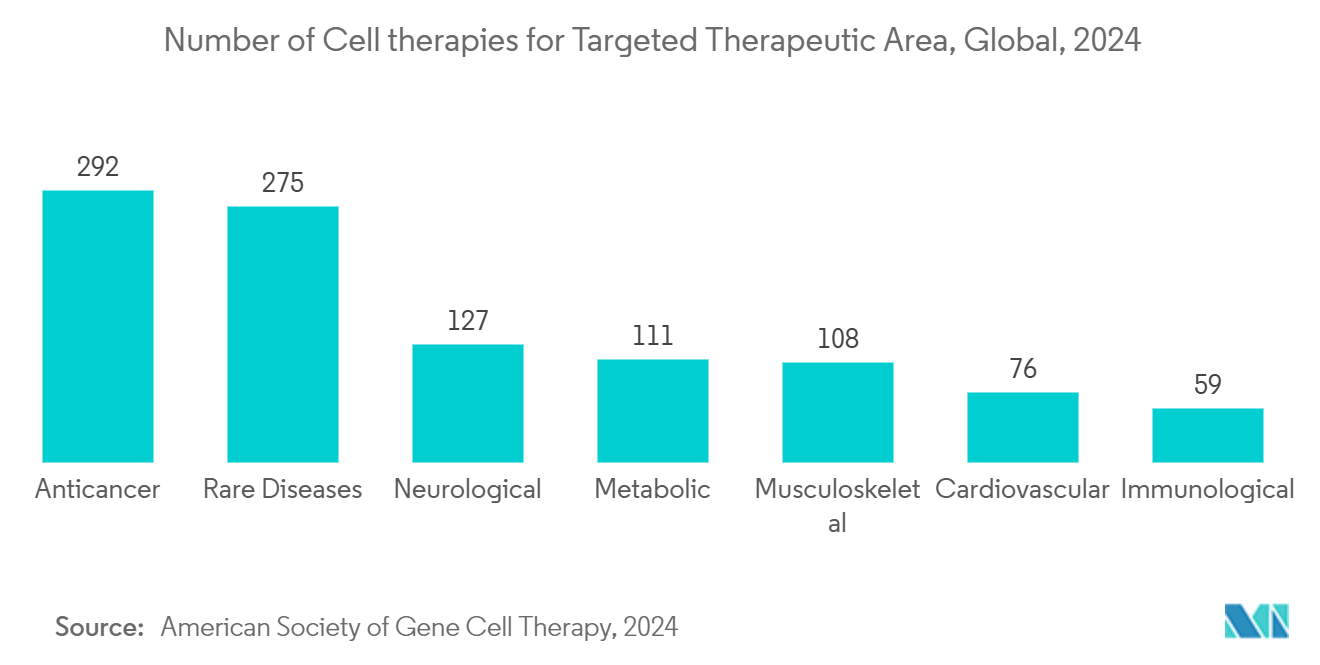
North America is Expected to Witness Growth During the Forecast Period
North America is estimated to hold a significant share of the global cell therapy market owing to key industry players and research institutes supporting research activities in the region. The market's significant growth in the region can be attributed to several factors, including the rising prevalence of chronic conditions, the growing adoption of regenerative medicine, and an increase in clinical studies focused on the development of cellular therapies.
The growing burden of chronic diseases such as cancer raises the need for cell therapy in the United States. For instance, in January 2024, as per the American Cancer Society 2024 update, the estimated number of new cancer cases in the United States is anticipated to be 2.0 million in 2024, which is an increase from the previous year's estimated cancer cases of 1.9 million. Thus, the rising cancer cases are likely to fuel the demand for effective cell therapy and contribute to the growth of the U.S. cell therapy market.
Rising investments from market players for developing and expanding cell-based therapies development in the United States are expected to drive the market in North America. For instance, in October 2023, Bayer AG invested USD 250 million in a new cell therapy manufacturing facility in the United States to support the production of materials needed for clinical trials and the potential commercial launch of BlueRock Therapeutics' bemdaneprocel (BRT-DA01), an investigational cell therapy under evaluation for the treatment of Parkinson's Disease. Thus, such investments by market players in developing novel therapies in this area are driving the growth of the U.S. cell therapy market during the forecast period.
Additionally, the enhanced outcomes of cell therapy products for cancer treatment are expected to result in increased product development, which should promote the growth of this market. For instance, in March 2024, Bristol-Myers Squibb received the US FDA approval for a CD19-directed chimeric antigen receptor (CAR) T cell therapy, Breyanzi (lisocabtagene maraleucel), indicated in the treatment of relapsed or refractory chronic lymphocytic leukemia (CLL) or small lymphocytic lymphoma (SLL). In addition, in January 2024, Kite, a Gilead company, received approval from the United States Food and Drug Administration for the change in the manufacturing process, which will lead to the reduction in the manufacturing time of CAR T-cell therapy Yescarta (axicabtagene ciloleucel) from 16 days to 14 days in the United States and the early release and delivery of Yescarta products, enabling healthcare professionals to provide better support to patients. Thus, rising product approvals in the region are anticipated to contribute to the market's growth.
Therefore, rising investments and research initiatives by the key market players and positive results of cell therapies are expected to drive the market's growth in North America, reflecting a positive U.S. stem cell therapy market outlook.
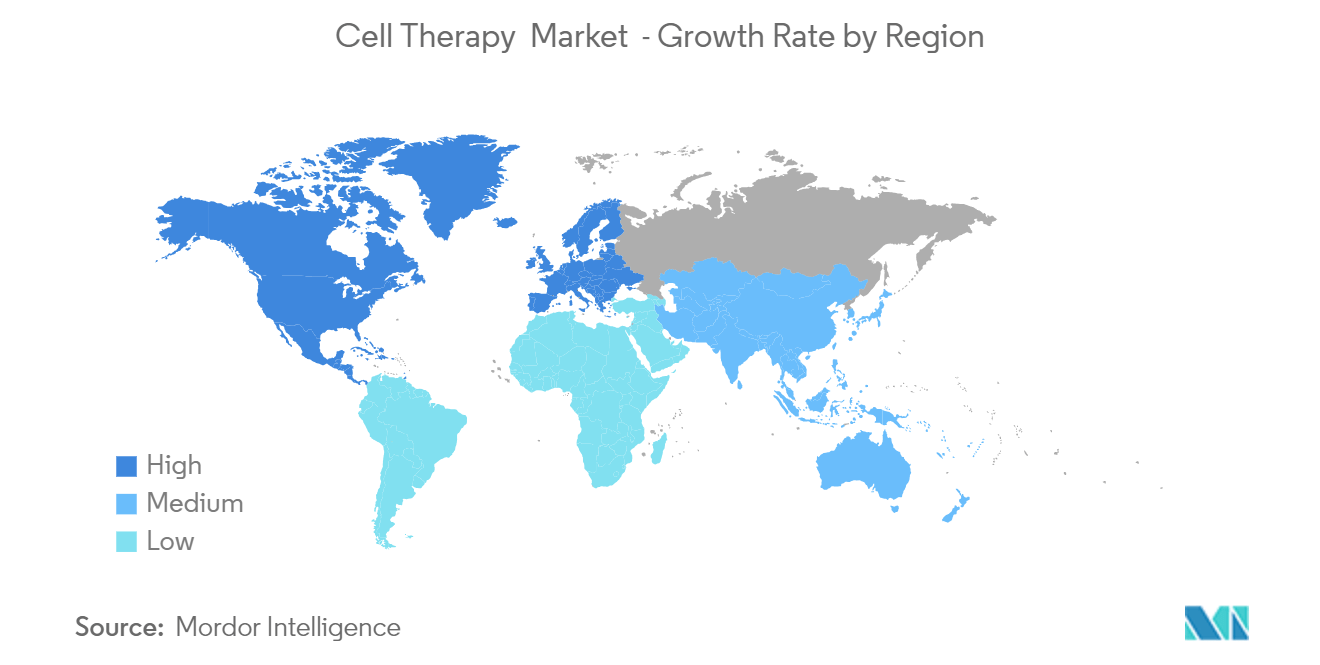
Cell Therapy Industry Overview
The cell therapy market is moderately competitive, with the presence of a considerable number of cell therapy companies. The major companies in the cell therapy industry are evolving through various strategies such as investment in research and development, acquisitions, partnerships, and collaborations to secure their market positions. The major companies in the market are Corestem Inc., Chiesi Farmaceutici SpA, Tegoscience, and Takeda Pharmaceuticals.
Cell Therapy Market Leaders
-
Corestem Inc.
-
Chiesi Farmaceutici S.p.A.
-
Tego Science
-
Allogene Therapeutics Inc.
-
Takeda Pharmaceuticals
- *Disclaimer: Major Players sorted in no particular order
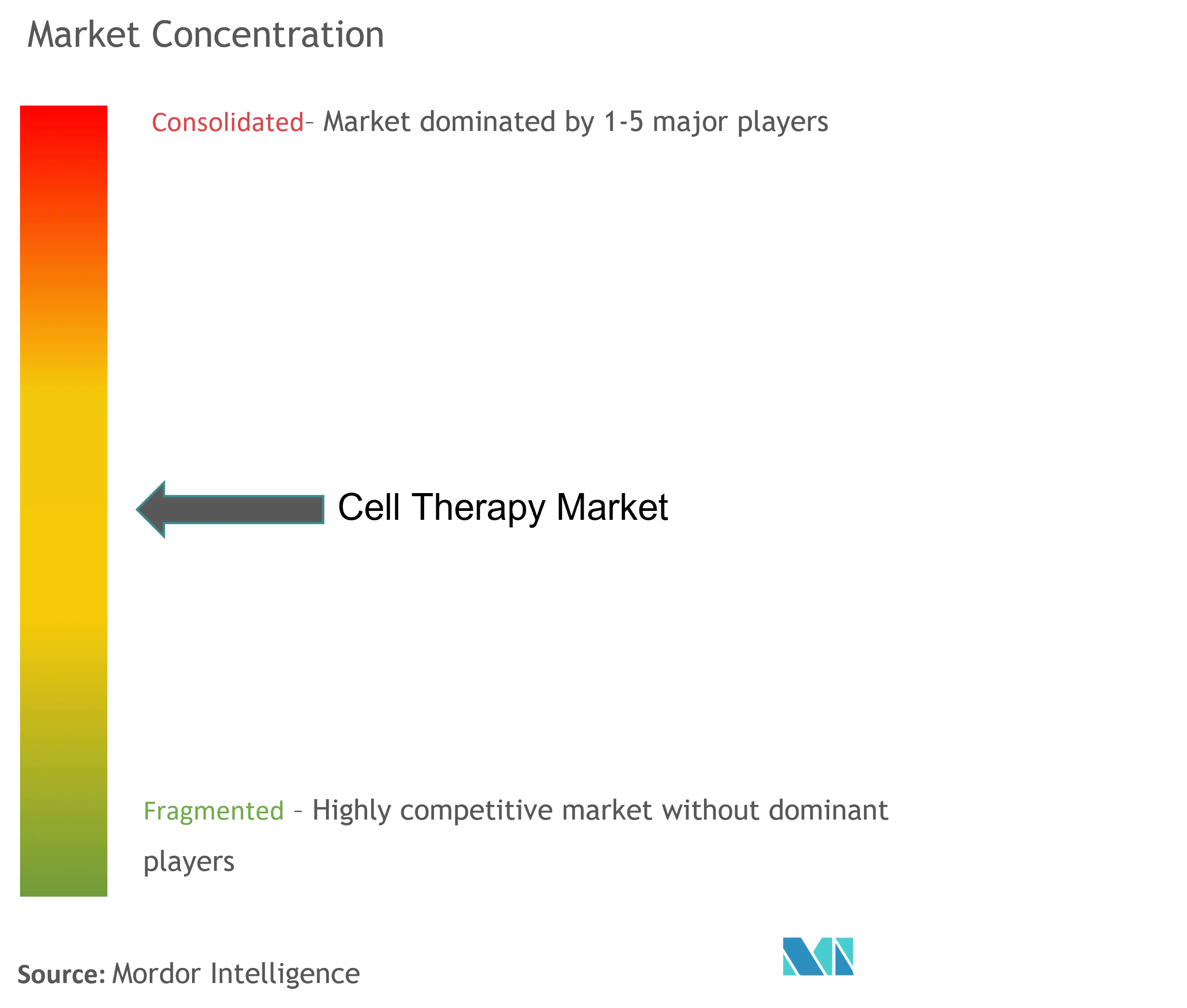
Cell Therapy Market News
- August 2024: Adaptimmune Therapeutics PLC was granted approval by the US FDA for TECELRA (afamitresgene autoleucel), marking it as the first engineered cell therapy approved for use in solid tumors and therapy for a rare, soft tissue cancer, synovial sarcoma.
- January 2024: Abbvie and Umoja Biopharma established a strategic collaboration to develop various in-situ generated CAR-T cell therapy candidates in oncology by incorporating Umoja's proprietary VivoVec gene delivery platform.
Cell Therapy Industry Segmentation
As per the scope of the report, cell therapy is known as a type of therapy in which live cells are injected into a patient for the treatment of a number of disorders by replacing diseased or dysfunctional cells with healthy functioning ones. Some of the cells used for the treatment include hematopoietic (blood-forming) stem cells (HSC), skeletal muscle stem cells, mesenchymal stem cells, lymphocytes, dendritic cells, and pancreatic islet cells.
The cell therapy market is segmented by type, therapy, application, and geography. By type, the market is segmented into autologous and allogeneic. By therapy, the market is segmented into mesenchymal stem cell therapy, fibroblast cell therapy, hematopoietic stem cell therapy, and other therapies. By application, the market is segmented into musculoskeletal, malignancies, cardiovascular, dermatology and wounds, and other applications. By geography, the market is segmented into North America, Europe, Asia-Pacific, Middle East and Africa, and South America. The market size is provided for each segment in terms of value (USD).
| Type | Autologous | ||
| Allogeneic | |||
| Therapy | Mesenchymal Stem Cell Therapy | ||
| Fibroblast Cell Therapy | |||
| Hematopoietic Stem Cell Therapy | |||
| Other Therapies | |||
| Application | Musculoskeletal | ||
| Malignancies | |||
| Cardiovascular | |||
| Dermatology and Wounds | |||
| Other Applications | |||
| Geography | North America | United States | |
| Canada | |||
| Mexico | |||
| Europe | Germany | ||
| United Kingdom | |||
| France | |||
| Italy | |||
| Spain | |||
| Rest of Europe | |||
| Asia-Pacific | China | ||
| Japan | |||
| India | |||
| Australia | |||
| South Korea | |||
| Rest of Asia-Pacific | |||
| Middle East and Africa | GCC | ||
| South Africa | |||
| Rest of Middle East and Africa | |||
| South America | Brazil | ||
| Argentina | |||
| Rest of South America | |||
Cell Therapy Market Research FAQs
How big is the Cell Therapy Market?
The Cell Therapy Market size is expected to reach USD 5.58 billion in 2025 and grow at a CAGR of 17.05% to reach USD 12.27 billion by 2030.
What is the current Cell Therapy Market size?
In 2025, the Cell Therapy Market size is expected to reach USD 5.58 billion.
Who are the key players in Cell Therapy Market?
Corestem Inc., Chiesi Farmaceutici S.p.A., Tego Science, Allogene Therapeutics Inc. and Takeda Pharmaceuticals are the major companies operating in the Cell Therapy Market.
Which is the fastest growing region in Cell Therapy Market?
Asia Pacific is estimated to grow at the highest CAGR over the forecast period (2025-2030).
Which region has the biggest share in Cell Therapy Market?
In 2025, the North America accounts for the largest market share in Cell Therapy Market.
What years does this Cell Therapy Market cover, and what was the market size in 2024?
In 2024, the Cell Therapy Market size was estimated at USD 4.63 billion. The report covers the Cell Therapy Market historical market size for years: 2021, 2022, 2023 and 2024. The report also forecasts the Cell Therapy Market size for years: 2025, 2026, 2027, 2028, 2029 and 2030.
Our Best Selling Reports
Cell Therapy Industry Report
The report covers an extensive market analysis of the global cell therapy technologies market, highlighting significant trends and industry research. The market overview includes a detailed segmentation by type, therapy, application, and geography, offering a comprehensive market outlook. Industry reports indicate a positive market growth trajectory, driven by advancements in mesenchymal stem cell therapy, fibroblast cell therapy, and hematopoietic stem cell therapy.
The market forecast suggests promising market value and market size expansion across various regions, including North America, Europe, Asia-Pacific, the Middle East and Africa, and South America. The industry statistics reveal substantial growth in applications such as musculoskeletal, malignancies, cardiovascular, dermatology, and wounds.
Market leaders are leveraging these trends to enhance their market share and industry size. The market trends and market predictions point towards a robust growth rate, supported by extensive industry information and industry outlook.
This report example, available as a report PDF, provides crucial market data and market review for stakeholders. The market segmentation analysis underscores the diverse applications and therapies driving the industry's evolution. The research companies involved in this study offer valuable insights into the industry's future trajectory, making this an essential resource for understanding the global market dynamics.




